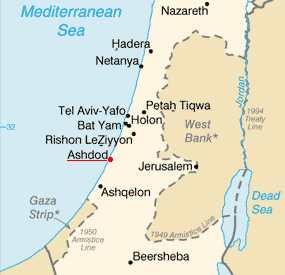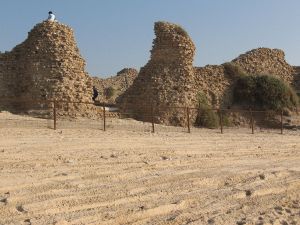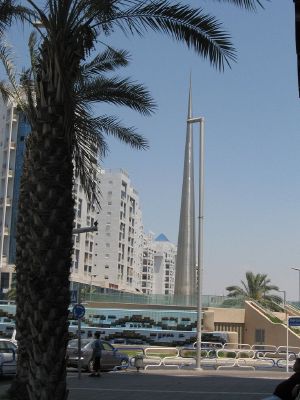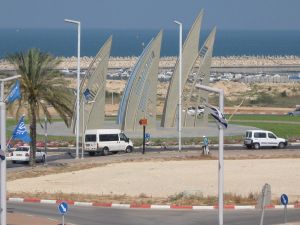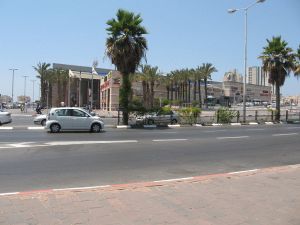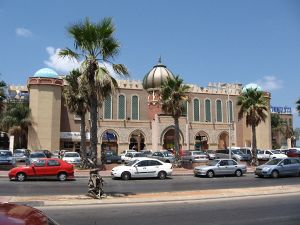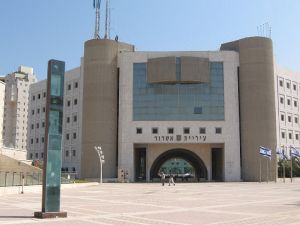Ashdod, Israel
| Ashdod | ||
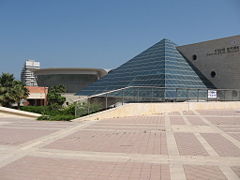 Ashdod MonArt Arts Centre. | ||
| ||
| Hebrew | אַשְׁדּוֹד | |
| Founded in | 1956 | |
| Government | City (from 1968) | |
| District | South | |
| Population | 204,400 (2005) | |
| Mayor | Zvi Zilker | |
Ashdod (Hebrew: אַשְׁדּוֹד; Arabic: إسدود, Isdud), located in the Southern District of Israel on the Mediterranean Sea coast, is a city of over 200,000 people located approximately 70 kilometers (43.5 mi) from Jerusalem and Beer Sheba. Ashdod is an important regional industrial center. The Port of Ashdod is Israel's largest port, and is southern Israel's only outlet to the Mediterranean. The artificial port, enclosed by breakwaters, accounts for sixty percent of the country's imported goods, while much of the country's citrus crop is exported through it.
The first documented settlement in Ashdod dates to the Canaanite culture of 17th century B.C.E.,[1] making the city one of the most ancient in the world. Ashdod is mentioned thirteen times in the Bible. During the history the city was settled by Philistines, Israelites, Byzantines, Crusaders and Arabs. [2]
Modern Ashdod was established in 1956 on the sand hills near the archeological site, and incorporated as a city in 1968, with a land-area of approximately 60 square kilometers (23.2 sq mi). It is 4.5 miles (7 km) north-northwest of the ancient city ruins. Being a planned city, expansion followed a main development plan, which facilitated traffic and prevented air pollution in the residential areas, despite population growth. According to the Israel Central Bureau of Statistics, Ashdod had a population of 204,400 at the end of 2006, makaing it the fifth largest city in Israel.
History
Ancient Ashdod
Human settlement in Ashdod dates from the Paleolithic Age. Ashdod is mentioned in Ugaritic documents, the language of the ancient Canaanites. At the end of the 13th century B.C.E. the Sea Peoples conquered and destroyed the city. By the beginning of the 12th century B.C.E. the Philistines, generally thought to have been one of the Sea Peoples, ruled the city. During their reign, the city prospered and was a member of union of five Philistine city states.
In 950 B.C.E. Ashdod was destroyed during Pharaoh Siamun's conquest of the region. The city was not rebuilt until at least 815 B.C.E. Around 715 B.C.E., it was conquered by Sargon II, who destroyed the city and exiled its residents. Jewish inhabitants of Ashdod were resettled in Media after their failed uprising attempt against Assyrian dominance. The records indicate that 27,290 Jews were forced to settle in Ecbatana (Hamadan) and Susa in South West Persia. [3]
Asdûdu led the revolt of Philistines, Judeans, Edomites, and Moabites against Assyria after expulsion of king Akhimeti, whom Sargon had installed instead of his brother Azuri. The city of Gath (Gimtu) belonged to the kingdom of Ashdod at that time.
An Assyrian general, Tartan, gained control of Ashdod in 711, ("In the year that Tartan came unto Ashdod, when Sargon the king of Assyria sent him, and fought against Ashdod, and took it": Isaiah 20:1) and forced the "usurper" Yamani to flee. Mitinti was king at the time of Sennacherib, and Akhimilki in the reign of Esarhaddon. Psammetichus of Egypt is reported to have besieged the great city Azotus for twenty-nine years (Herodotus, ii. 157); the biblical references to the remnant of Ashdod (Jeremiah 25:20; cf Zephaniah 2:4) are interpreted as an allusion to this event.
The city absorbed another blow in 605 B.C.E., when Nebuchadnezzar conquered it. In 539 B.C.E. the city was rebuilt by the Persians, but was conquered in the wars of Alexander of Macedon (Nehemiah 13:23).
According to the Book of Nehemiah, the Ashdodites seem to represent the whole nation of the Philistines in the sixth century B.C.E., the speech of Ashdod (which the younger generation of the Jews are described as adopting) would simply be the general Philistine dialect. The historian Hugo Winckler explained the use of that name by the fact that Ashdod was the nearest of the Philistine cities to Jerusalem. [4]
The city prospered as Izotus under the Hellenistic rule, until the Hasmonean Revolt. During the rebellion Judas Maccabeus arrived at its gates, but did not conquer it. He left it for his brother Jonathan, who conquered it in 147 B.C.E. and destroyed the Temple of Dagon. According to Josephus (Antiquities of the Jews 13:15, volume 4), Alexander Jannæus possessed it. Pompey restored its independence by reconstructing its city walls, though it belonged to the dominion of Herod and Salome (Antiquities... 17:18, volume 9), and Vespasian had to later take it by force.
Despite its location four miles from the coast, both Ptolemy and Josephus described it as a maritime city. This curious description may refer to Ashdod's control of a separate shore-edge harbor, called Azotus Paraliyus, or Ashdod-Sea (Antiquities... 13:15, volume 4). The city's prominence continued until the seventh century, when a citadel was built in Azotus Paraliyus as a stronghold against the Byzantine navy. To the west of the wooded height on which the city stands, traces of the ancient harbor—now known as Minet el-Ḳal'a—can still be seen.
The Fatimids established a shore fortress and a village on the Tell of Ashdod. The location of the village on Via Maris enhanced the city's importance during the Ottoman rule. In 1596 C.E., the population of Ashdod numbered about 413. At the beginning of the twentieth century the village was known as Esdūd, with a population of about five thousand, specializing in agriculture and trade. [5]
Biblical mentions
According to the bible, during the 10th century B.C.E. Ashdod became, along with all the kingdom of Philistia a patronage area of the Kingdom of Israel under the control of King David. Judah's claim upon Ashdod is mentioned in the Book of Joshua (Joshua 15:46).
In the Book of Samuel Ashdod is mentioned (I Samuel 6:17) among the principal Philistine cities. After capturing the Ark of the Covenant from the Israelites, the Philistines took it to Ashdod, where it was placed in the temple of Dagon. The next morning Dagon was found prostrate, bowed down, before it; on being restored to his place, he was on the following morning again found prostrate and broken. The people of Ashdod were smitten with boils; a plague of mice was sent over the land (1 Samuel 6:5).
In the Book of Isaiah an Assyrian general named Tartan, sent by Sargon, gained control of Ashdod in 711. (Isaiah 20:1)
The capture of the city by King Uzziah shortly after 815 B.C.E. is mentioned within the text of the Book of Chronicles (2 Chronicles 26:6) and in the Book of Zechariah (Zechariah 9:6), speaking of the false Jews.
HERE
Modern times
Immediately before the 1948 Arab-Israeli War, the Egyptian Army took over Isdud, and the city became the northern-most advancement point of the Egyptian forces. Egyptian and Israeli forces clashed in the surrounding area, with the Egyptians being halted at the Ad Halom bridge over the Lachish River. Israeli forces surrounded the city during Operation Yoav, and shelled and bombed it from the air. Fearing encirclement, Egyptian forces retreated on October 28, 1948 with a majority of the city's residents. [6]
In 1953, surveyors and designers arrived at the desolate dunes near the mouth of Lachish River to choose a site to build a new power station in the south of the country (eventually "Eshkol A"). Its workers lived in the regional settlements Rehovot and Gedera.
On May 1, 1956, then finance minister Levi Eshkol approved the establishment of the city of Ashdod. The first settlers, twenty-two families of Jewish immigrants from Morocco arrived in November 1956, and a group of immigrants from Egypt joined them. In July 1957, the government granted a 24,000 dunam (24 km²) concession, approximately 32 km from Tel Aviv, to the Ashdod Company Ltd., for building the modern city of Ashdod.
The building of the Eshkol A power station in Ashdod was completed in 1958 and included 3 units: 2 units of 50 MW, and one unit of 45 MW (with the ability of sea water desalination).
The first local council was appointed in October 1959. Dov Gur was appointed on behalf of the Israeli Ministry of Interior as the first local council head. The Magistrates' Court in the city was inaugurated in 1963, and, in January 1965, a contract between Ashdod Company and the General Health Maintenance Organization was signed regarding establishment of a hospital with 500 beds on an area of 250 dunams (250,000 m²) — a hospital which has yet to be established. The building of the port of Ashdod began in April 1961. The port was inaugurated in November 1963, and was utilized for the first time in November 1965 with the coming of the Swedish ship "Wiengelgad".
In 1964 the Ponevezher Rov, Rabbi Yosef Shlomo Kahaneman established the Ponevezh development, the first Hareidi neighborhood in Ashdod. In 1978 a joint Belz-Ger estate was established in Neighbourhood 3 (Rova Gimel). The Lev Simcha Talmud Torah in Ashdod is the largest cheder (a traditional elementary school teaching the basics of Judaism and the Hebrew language) in Israel. Today, the Tolna Rebbe, Pittsburgher Rebbe, Neshchiz, and Melitzer Rebbes reside in Ashdod.
The explosive growth of the city began in 1991, with the massive arrival of immigrants from the Soviet Union and infrastructure development. From 1990 to 2001 the city accepted more than 100,000 new inhabitants, a 150 percent growth.
- Carta Jerusalem (2003). Battle Sites in the Land of Israel (in Hebrew). Israel: Carta, p. 24. ISBN 965-220-494-3.
- R.Yaniv (1990). Ashdod. From repatriants settlemnt to the City (in Hebrew). Israel: SPNI Ashdod branch, p.163.
Planned City
The modern city of Ashdod city was built outside of the Ashdod historic sites on virgin sands. The development over the years followed a main development plan[7]. The planners divided the city into seventeen neighborhoods of ten to fifteen thousand people each. Wide avenues between the neighborhoods make traffic flow relatively freely inside the city. Each neighborhood has easy access to its own commercial center, urban park, and health and education infrastructure. The plan also called for a business and administrative center, but this had to wait until the mid-1990s when the city population grew rapidly, more than doubling in ten years.[8]
Three industrial zones were placed adjacent to the port in the northern part of the city, taking into account the prevailing southern winds which take air pollution out of the city[7]. The plan had its problems, however, including asymmetric growth of upscale and poorer neighborhoods and the long-time lack of a main business and administrative center[9].
The city was planned for a maximum of 250,000 inhabitants, and an additional area in the south was reserved for further development[7]. However, the southern border of the city was proclaimed a national nature reserve, Ashdod Nitzanim Sand Dune Park, which makes future city growth problematic, with the last of the seventeen neighborhoods of the development plan now under construction.
Climate
Ashdod has a mediterranean climate with hot summers, pleasant spring and fall, and cool, rainy winters. Humidity tends to be high all year round, and rain occurs usually between October to May. In winter, temperatures seldom drop below 5°C and are more likely to be in the region of 10° to 15°C, while in summer the average is 27°C. The average annual rainfall is 510 millimeters.
| Weather averages for Ashdod | |||||||||||||
| Month | Jan | Feb | Mar | Apr | May | Jun | Jul | Aug | Sep | Oct | Nov | Dec | |
|---|---|---|---|---|---|---|---|---|---|---|---|---|---|
| Avg high °C (°F) | 17.2 (63.0) | 17.5 (63.5) | 19.7 (67.5) | 24.6 (76.3) | 27.4 (81.3) | 29.5 (85.1) | 30.8 (87.4) | 31.1 (88.0) | 30.2 (86.4) | 27.9 (82.2) | 23.6 (74.5) | 19.2 (66.6) | |
| Avg low °C (°F) | 8.1 (46.6) | 8.0 (46.4) | 9.3 (48.7) | 11.9 (53.4) | 14.8 (58.6) | 18.0 (64.4) | 20.6 (69.1) | 21.4 (70.5) | 20.1 (68.2) | 17.5 (63.5) | 13.1 (55.6) | 9.8 (49.6) | |
| Precipitation mm (in) | 127.9 (51.0) | 98.6 (39.3) | 61.4 (24.5) | 17.8 (7.1) | 3.0 (1.2) | 0 (0) | 0 (0) | 0 (0) | 2.3 (0.9) | 19.0 (7.6) | 69.8 (27.8) | 114.7 (45.7) | |
| Source: Israel Central Bureau of Statistics [10][11] | |||||||||||||
Economy
Industry
Ashdod is one of the most important industrial centers in Israel. All industrial activities in the city are located in northern areas such as the port area, the northern industrial zone, and around the Lachish River. The port of Ashdod is the largest port in Israel, handling about sixty percent of Israel's port cargo. It was mainly upgraded in recent years and will be able to provide berths for Panamax ships. [12][13] Various shipping companies offices are also located in the port area which also is home to a Eshkol A power station and coal terminal.
The Northern industrial zone is located on Highway 41 and includes various industry including an oil refinery, which is one of only two in the country. The heavy industry zone located south of the Lachish River was once the main industrial center in Ashdod. Recently, however, leisure facilities have moved into the area. There is still some industry here, however, such as a Teva Pharmaceutical Industries plant, construction components producer Ashtrom, and Solbar a soybean oil producer. Ashdod is also home to Elta, a part of Israel Aircraft Industries where radar equipment, electronic warfare systems, and ELINT are developed.
Shopping
Historically each neighborhood of Ashdod had its own commercial center and at different times some of these centers became the main shopping areas of the city such as Rogozin St. during the 1980's. In 1990, however, when the mall culture developed in Israel, the main commercial activity in Ashdod moved to malls.
The first mall to open in Ashdod was the Forum Center which was built in the industrial zone and was very popular until additional malls were built in the residential neighborhoods. Restaurants, bars and night clubs were opened in the area which is one of the most popular recreation zones in the city. Today, the Forum center is mainly used for offices.
Lev Ashdod Mall was opened in 1993 and soon became the most popular shopping and recreation place among the population of Ashdod[14]. The mall has been extended and upgraded in the years since its opening. Lev Ashdod Mall was followed two years later by Ashdod Mall which opened in 1995 and was at the time the biggest mall in the city. Despite this fact, however, it was not successful and is currently being closed and redesigned. [15]
City Mall was opened in a combined building with the central bus station in 1996[16], following the examples of the Tel Aviv Central Bus Station and the Jerusalem Central Bus Station. Due to its location in the city center it is highly popular and was upgraded in 2007.
The Sea Mall is a new three floor mall. It is located in a modern building near the government offices and also has a climbing wall and cinema.
Finally, Star Center is a new shopping center which has proven to be popular to the extent that it doubles in size in 2007[17] .
Transportation
Roads
Ashdod is located on the historic Via Maris. Highway 4 was developed following this route along the southern sea shore of Israel; it serves as the main connection to the north, towards the Tel Aviv metropolitan area, and to the south, towards Ashkelon.
Ad Halom junction was planned as the main entrance to the city from the east.[9] The junction was poorly planned and built, including a grade-level railway crossing less than 100 meters from the intersection with Highway 4 and a dangerous intersection with the nearby railway station's access road, and it currently suffers from heavy congestion. An interchange is under construction, planned to open in 2009. [18] The interchange is intended to continue the freeway section of Highway 4 further south by removing the traffic light at this junction, and it will also utilize grade separation with the railway.[18]
The other main road in the area is Highway 41 which served the city from the start of its modern history. This road runs from west to east towards Gedera and it is the main transport link to the port of Ashdod and the industrial zones, and connects to Highway 4 with an interchange.
Railroad
The passenger railroad connection to Ashdod opened in 1992[19] after the renovation of the historical railway to Egypt.[20] Ashdod railway station is on Israel Railways' Binyamina/Netanya - Tel Aviv - Ashkelon line and it is located near Ad Halom Junction. The station was upgraded in 2003[19] when a new terminal building was built. The station is modern and has all the usual facilities, but road access to it is old and clumsy. A new access road is currently under construction[21].
There is also heavy freight traffic in the area. Port of Ashdod has its own railway branch line as well as a special terminal for potash brought from the Sodom area and exported abroad.
Buses
The new central bus station opened in 1996. It serves as the terminus both for inter- and intracity lines. The building also includes a small but popular shopping mall. The bus lines connect the city with all major population centers in Israel. These routes are served by Connex, Metropoline, and the Egged Bus Cooperative.
Sea Transport
There is a passenger pier in the Port of Ashdod. The traffic at this gateway is constantly growing, especially due to cruise ship activities. The other sea gateway is the newly opened Blue Marina.
Demographics
Population
| Year | Population |
|---|---|
| 1961 | 4,600[22] |
| 1972 | 40,300 |
| 1983 | 65,700[23] |
| 1990 | 83,900 |
| 1995 | 125,820 |
| 1996 | 137,100 |
| 2000 | 174,224 |
| 2001 | 187,000 |
| 2003 | 192,200[24] |
| 2006 | 204,400 |
According to the Israel Central Bureau of Statistics, Ashdod had a population of about 204,400 at the end of 2006, making it the fifth largest city in Israel.[25] The annual population growth rate is 2.6% and the ratio of women to men is 1,046 to 1,000.
The population age distribution was recorded as 19.7% under the age of 10, 15.7% from age 10 to 19, 14.9% from 20 to 29, 19.1% from 30 to 44, 19.1% from 45 to 64, and 11.3% were 65 or older. The population of Ashdod is significantly younger than the Israeli average because of the large number of young couples living in the city.
The city is ranked medium-low in socio-economic grading, with a rating of 4 out of 10. 56.1% of 12th grade students in Ashdod were eligible for matriculation certificates in 2000. The average salary in 2000 was NIS 4,821 compared to the national average of NIS 6,835.
Origins
Ashdod, like many Israeli cities, has seen much of its growth as the result of absorption of immigrants. The first major group to move to the city were Jews of Moroccan and Egyptian descent[26]. In the 1960s Ashdod accepted a large number of immigrants from Romania, followed by a large number from Georgia[26] and India in the 1970s. More than 60,000 Jews immigrated to Ashdod from the former Soviet Union in the early 1990s. Recent demographic figures suggest that about 32%[27] of the city's population are new immigrants, 85% of whom are originally from the former Soviet Union.
During the 1990s the city absorbed a large number of Jews of Ethiopian descent, and in more recent years Ashdod has absorbed a large number of immigrants from France and Argentina.
Ashdod also receives a significant amount of internal migration[28], especially from the Gush Dan region.
Religion
Over 95% of Ashdod's population is Jewish, over 30% of whom are religiously observant. Despite this, the city is generally secular, although most of the non-Jewish population is a result of mixed marriages. The large Haredi community of the city live mainly in Neighborhood 7 (Rova Za'in) which is specially dedicated for their needs with Talmud Torah, Cheder, Mikvah and other religious institutions.
Ashdod is home to a wide range of synagogues, catering to the religious diversity of its population. The city is home to the world's largest[29] Karaite community, about five thousand strong. There is also a Scandinavian Seamen Protestant church, established by Norwegian Righteous Among the Nations pastor Per Faye-Hansen.[30][31]
Government
The Ashdod City Council has twenty-five elected members, one of whom is the mayor. The mayor serves a five-year term and appoints six deputies. The current mayor of Ashdod, Zvi Zilker was last elected in 2003 and has been in office continuously since 1989.[32] Within the city council there are various factions representing different population groups, both secular and religious. The headquarters of the Ashdod Municipality and the mayor's office are at city hall. This new municipal building is located in the main culture and business area.
Mayors
- Robert Hayim was chosen to the council chairmanship in the first municipal elections, in 1961[33] .
- 1963 - Avner Garin
- 1969 - Zvi Zilker
- 1983 - Aryeh Azulay
- 1989 - Zvi Zilker
Culture
Music and theatre
Ashdod is home to the Israeli Andalusian Orchestra which performs music originating in Andalusia, a blend of Western and Arabic music. The orchestra was awarded the Israel Prize in 2006.[34][35]
The ACADMA conservatory, a professional educational institute for music and performance studies is based in Ashdod. Operated under the supervision of the Ministry of Education, the institute was established in 1966[36], and serves as a home for 600 young musicians in different fields. The conservatory is a vivacious and vigorous center of the music and the culture life in the city, and it is involved in the community life and educates a second generation of musicians made in Ashdod.
The MonArt center is a newly opened performing arts center which has different art schools, studios and events. Theater and concerts are hosted in several cultural venues; the most important are performed at Yad LaBanim concert hall. The new city concert hall is in its final building stages, and will enlarge capacity to 1600.
Museums and exhibitions
- The Korin Maman Museum has a permanent archeology exhibition called "Philistian World" as well as various changing art exhibitions.[1]
- Ashdod Art Museum located in the MonArt center, has 13 exhibition halls.[2]
Sports
Ashdod's football team, FC Ashdod represents the city in Ligat ha'Al, Israel's Premier League. The club is known for its successful soccer school. The city's top basketball team is Maccabi Ashdod. The men squad plays in Liga Leumit, Israel's second tier league, and the women squad plays in top division.
Ashdod plays host to many national and international sporting tournaments, including the annual Ashdod International Chess Festival.[37] The city has a cricket team[38], a rarity in Israel. It is run and organized by citizens of Indian descent. Like many coastal settlements in Israel, Ashdod's beaches is a venue for water sport, like as windsurfing, yachting, and SCUBA diving operating in the Marina area.
Ashdod has produced a number of famous sportsmen:
- Haim Revivo - international soccer player
- Alon Hazan - international soccer player
- Vered Borochovsky[39] - 2000 Sydney Olympics and 2004 Summer Olympics swimmer.
- Gocha Tzitziashvili[40] - 2003 Greco-Roman Wrestling World champion & 2004 Summer Olympics wrestler
Notes
- ↑ M. Dotan (1990). Ashdod - Seven levels of excavations (in Hebrew). Israel: Society for the Protection of Nature in Israel, Ashdod branch, 91.
- ↑ O.Kolani, B.Raanan, M.Brosh, S.Pipano (1990). Events calendar in Israel and Ashdod (in Hebrew). Israel: Society for the Protection of Nature in Israel, Ashdod branch, 79.
- ↑ Price, Massoume. 2001. A brief history of Iranian Jews Iran Chamber Society. Retrieved December 4, 2007.
- ↑ Wilckner, Hugo. 1898. Geschichte Israels.
- ↑ PalestineRemembered.com. Isdud, District of Gaza Retrieved December 4, 2007.
- ↑ International Middle East Media Center. April 14, 2006. From Isdud to Ashdod: One man's immigrant dream; another's refugee nightmare Retrieved December 4, 2007.
- ↑ 7.0 7.1 7.2 Development Plan for city of Ashdod (PDF). The Society of Protection of Nature in Israel, Ashdod branch.(Hebrew)
- ↑ Cite error: Invalid
<ref>tag; no text was provided for refs namedLandver Data - ↑ 9.0 9.1 J. Herz U. Fogel (1990). New lineation plan to the city of Ashdod (in Hebrew). Israel: SPNI Ashdod branch, p.29.
- ↑ Monthly Average of Daily Maximum and Minimum Temperature. Statistical Abstract of Israel 2006. Israel Central Bureau of Statistics.
- ↑ Precipitation. Statistical Abstract of Israel 2006. Israel Central Bureau of Statistics.
- ↑ Ashdod Port Development, Israel. Port Technology. Retrieved 2007-09-20.
- ↑ Eitan Port - A NIS 3 Billion Project Among Israel's Largest Infrastructure Projects. Ports and Railways Authority. Retrieved 2007-09-20.
- ↑ kenyonim.com. "Lev Ashdod Mall". (Hebrew)
- ↑ Ashdod News (2005-12-01). "Ashdod Mall closed its gates". Retrieved 2007-09-29. (Hebrew)
- ↑ kenyonim.com. "City Mall, Ashdod". (Hebrew)
- ↑ Filgar broaden Star Center cite in Ashdod (Word). Debby Communications Ltd (2006). Retrieved 2007-09-25. (Hebrew)
- ↑ 18.0 18.1 Government approved today (11/12/05) Minister of Finance and Minister of Transport proposal for a five-year plan for the design, development, paving, safety and maintenance of intercity roads, at a volume of NIS 19 billion (Word). Israeli Ministries of Finance and Transport (2005-12-11). Retrieved 2007-09-20.
- ↑ 19.0 19.1 The duplication of section Pleshet jnct. - Ashdod, Ad Halom and upgrading of railway station Ashdod, Ad Halom (in Hebrew). Raiway News Israel (2004-05-30). Retrieved 2007-09-26.
- ↑ General Information - Milestones. Israel Railways official cite. Retrieved 2007-09-26.
- ↑ (2006) News. Access road to railway station. Transport Today & Tomorrow, Vol.14. (Hebrew)
- ↑ Israel Central Bureau of Statistics. Israel in Figures, Population.
- ↑ City Population. The districts of Israel and all Israeli cities of more than 20,000 inhabitants.
- ↑ Jewish Virtual Library. Latest Population Figures for Israel.
- ↑ Israel Central Bureau of Statistics estimate as of the end of June 2006 (July 2005). TABLE 3. - POPULATION(1) OF LOCALITIES NUMBERING ABOVE 1,000 RESIDENTS (Excel). CBS.
- ↑ 26.0 26.1 Cite error: Invalid
<ref>tag; no text was provided for refs namedModernT - ↑ Ashdod Municipality. Absorption and immigration.
- ↑ Israel Central Bureau of Statistics. Internal migration in Israel.
- ↑ Last Days Reporters. 7 Stages of the beginning of Judaism.
- ↑ Righteous Among the Nations, Norway. Per Faye-Hansen. Yad Vashem The Holocaust Martyrs' and Heroes' Remembrance Authority. Retrieved 2007-09-26.
- ↑ Bilateral Relations. Per Faye-Hansen recognised as Righteous Among the Nations. Norway - the official cite in Israel. Retrieved 2007-09-26.
- ↑ Local council elections 2003 results. Haaretz (October 29, 2003). (Hebrew)
- ↑ Cite error: Invalid
<ref>tag; no text was provided for refs namedMajors - ↑ Barnea, Or (2006-04-04). Israel Prize awarded to Dvora Omer. Ynet. Retrieved 2007-09-16.
- ↑ Israel Prize Recipients 2006- Israeli Andalusit Orchestra (in Hebrew). Israel Ministry of Education. Retrieved 2007-09-16.
- ↑ Yannai, Bezalel (2002-07-11). Sounds from the South. Israel Ministry of Foreign Affairs. Retrieved 2007-09-16.
- ↑ Ashdod International Chess festival
- ↑ Cricket revolution in Ashdod(Hebrew)
- ↑ Identity. Vered Borochovsky. The-sports.org. Retrieved 2007-09-18.
- ↑ Two world championships for Israeli athletes. Israel21c. Retrieved 2007-09-18.
Resources
- B.Frenkel (1990). The Philistines (in Hebrew). Israel: Society for the Protection of Nature in Israel, Ashdod branch, 119.
- Cogan, Mordechai (1993), "Judah under Assyrian Hegemony: A Reexamination of Imperialism and Religion", Journal of Biblical Literature 112 (3): 403-414
- J. Kaplan (1990). Yamani stronghold in Ashdod-Sea (in Hebrew). Israel: Society for the Protection of Nature in Israel, Ashdod branch, 125.
- H. Tadmor (1966), "Philistia under Assyrian Rule", The Biblical Archaeologist 29 (3): 86-102
- S.Shapira (1990). Battle of Ashdod (147B.C.E.) (in Hebrew). Israel: Society for the Protection of Nature in Israel, Ashdod branch, 135.
- S.Piphano (1990). Ashdod Sea in Byzantic period (in Hebrew). Israel: Society for the Protection of Nature in Israel, Ashdod branch, 143.
- Harris JC (2006). The plague of Ashdod. Arch. Gen. Psychiatry 63 (3): 244–5.
External links
- Ashdod official website
- Ashdod Port official website
- Ashdod Local News (in Hebrew)
- Ashdod City Promo Video (Hebrew)
- Ashdod Image Gallery
- The Israeli Andalusit Orchestra
| Southern District | ||
|---|---|---|
| Cities | Arad · Ashdod · Ashkelon · Beersheba · Dimona · Eilat · Kiryat Gat · Kiryat Malakhi · Netivot · Ofakim · Rahat · Sderot | 
|
| Local councils | Ar'arat an-Naqab · Hura · Kuseife · Lakiya · Lehavim · Meitar · Mitzpe Ramon · Omer · Shaqib al-Salam · Tel as-Sabi · Yeruham | |
| Regional councils | Abu Basma · Be'er Tuvia · Bnei Shimon · Central Arava · Eshkol · Hevel Eilot · Hof Ashkelon · Lakhish · Merhavim · Ramat Negev · Sdot Negev (Azata) · Sha'ar HaNegev · Shafir · Tamar · Yoav | |
Credits
New World Encyclopedia writers and editors rewrote and completed the Wikipedia article in accordance with New World Encyclopedia standards. This article abides by terms of the Creative Commons CC-by-sa 3.0 License (CC-by-sa), which may be used and disseminated with proper attribution. Credit is due under the terms of this license that can reference both the New World Encyclopedia contributors and the selfless volunteer contributors of the Wikimedia Foundation. To cite this article click here for a list of acceptable citing formats.The history of earlier contributions by wikipedians is accessible to researchers here:
The history of this article since it was imported to New World Encyclopedia:
Note: Some restrictions may apply to use of individual images which are separately licensed.
